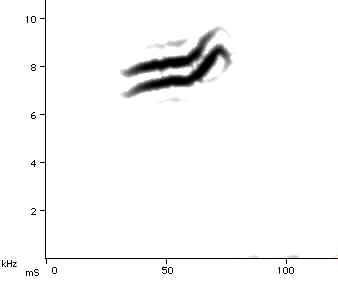
Tennessee Warbler Vermivora peregrina
Flight call description A sharp, rising "tseet" with a tinny quality.
Fig.1. Maryland September 19, 1994 (MO).
Bird in flight.
Examples Diurnal
Similar species The "double-banded up-seep" group including Tennessee, Nashville, Orange-crowned, Black-throated Green, and Golden-cheeked Warblers are all nearly identical and often not separable. However, with much experience, average differences between these calls can be heard, allowing for the accurate identification of many individuals. Within this complex, Nashville and Orange-crowned are the most similar, typically sounding drier and softer at the beginning than the others. Nashville averages slightly louder and huskier than Orange-crowned. Tennessee and Black-throated Green often have a distinctive tinny quality and sharp beginning. Between these two, Tennessee averages sharper at the end and with more of a long "e" sound, and Black-throated Green averages softer or more hollow-sounding at the end. We have not differentiated Golden-cheeked from the rest of this group because our sample for that species is too small. See also Mourning Warbler and short rising seeps.
Behavior Primarily a nocturnal migrant but engages in redetermined migration and limited resumed migration. Gives flight call regularly while perched and in flight during the day and presumably during nocturnal migration.
Spectrographic description Measured calls (N=19) were 22.4-53.1 (43.5) mS in duration and in the 6.2-10.2 (6.7-8.8) kHz frequency range. The frequency track was double-banded and rising. It frequently showed an upward bend somewhere in the middle and often a slight downward hook at the end. It was usually unmodulated but occasionally showed fine modulations throughout the call with a spacing of 4.3-5.6 (4.7) mS between humps.